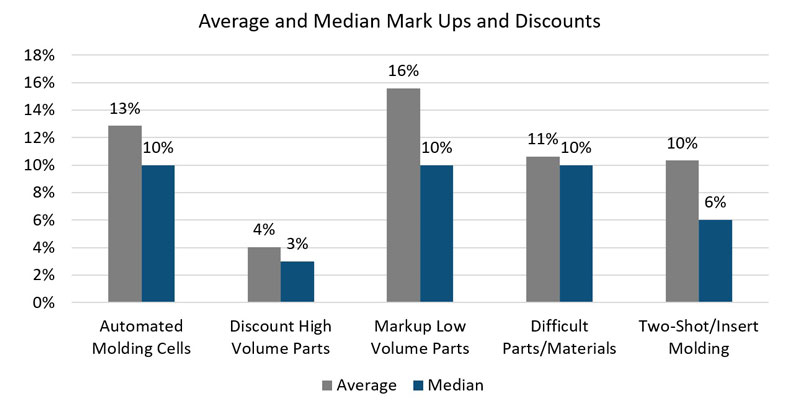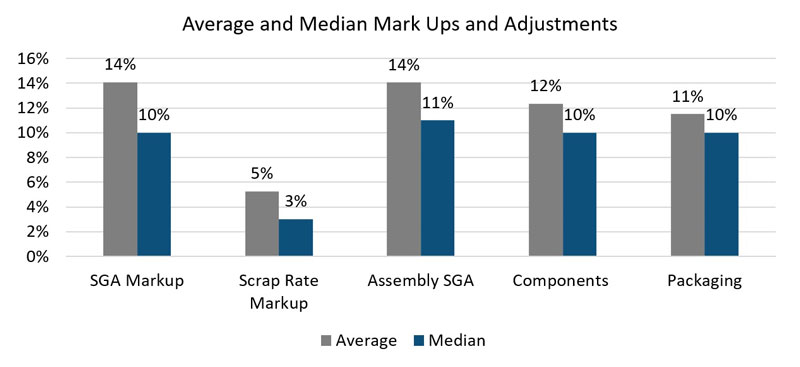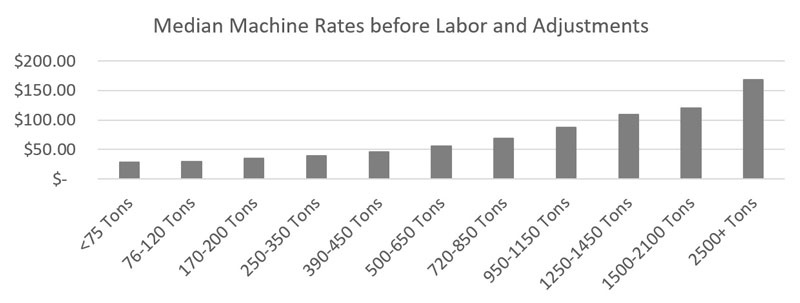by Ashley Turrell, membership and analytics director
MAPP
When developing and evaluating machine rates for injection molders, there is hardly a one-size-fits-all option. Instead, a myriad of factors come into play, and those variables are unique to each company. Instead of looking at machine rates as a snapshot of data, molders should dive deeper into what variables need to be taken into consideration. Machine rates across the industry are just part of a whole and need to be reviewed regularly for quoting and budgeting purposes.
The 2019 Plastics Industry Machine Rate Report, recently published by the Manufacturers Association for Plastics Processors (MAPP), takes a comprehensive look into multiple factors that impact an organization’s machine rate. With inputs from more than 250 plastics companies, across 18 different industries and from all areas of the US, the report is able to analyze and present data that affect companies’ machine rates.
Reported machine rates for injection molders range from $20.00 per hour to $328.90 per hour. The most easily defined factor at play is machine tonnage. Reported machine rates for machines under 75 tons average around $31.00 per hour without labor or selling, general and administrative expenses (SG&A), while larger presses approach closer to $200.00 per hour. Beyond the obvious variable of machine size, manufacturing environment, industry served, labor costs and a variety of markups have an impact on the hourly rates manufacturers put on their machines.
To start, the MAPP report examines labor/burden rates. In essence, this rate is the average machine operator labor rate divided by the number of press operators per machine. For example, if two operators are needed at a machine at an average of $8 per hour, the labor/burden rate is $16.00. However, if only one operator is working on two machines at an average of $8 per hour, the labor/burden rate is $4.00. Labor/burden rates reported range from $2.00 to $42.00, and these vary greatly based on company size, region and industry served. The median labor/burden rate overall reported was $16.00. The large variance can be attributed to numerous variables, including but not limited to wage requirements, machine and cell efficiency, operator knowledge/necessary skill level and part complexity.
A major factor plastics companies must examine is markups. In the 2019 report, the following markups are analyzed: SG&A, scrap rate, assembly, components, packaging, automated molding cells, difficult parts or materials, two-shot and insert molding, discount for high-volume parts and markups for low-volume parts. Overall, the median markup for most adjustments sits at 10%. On average, low-volume parts receive the highest average markup of 16%, while discounts for high-volume parts received the lowest average adjustment of 4%.
Additionally, the environment in which parts are being manufactured factors into machine and labor rates as well – specifically, open production environments vs. cleanroom manufacturing environments. On average, manufacturers apply a 15% markup when manufacturing in a cleanroom environment is required. In terms of specific product lines, internal medical devices and food and beverage containers see the highest markups for cleanroom manufacturing costs, while pharmaceutical products experience the lowest average markup.
Perhaps some of the most revealing data are showcased when manufacturers dive deeper into the data based on the primary industry served. Of all industries reporting data into this study, automotive, medical, consumer goods and industrial were the most common. Each of these industries has a dedicated appendix within the report. Between the four industries, medical tends to have the highest average markup rate across the board, while the consumer goods sector tends to be lowest. These trends are especially pronounced when looking at SG&A markups (10% on average overall, but 20% markup in the medical industry) and assembly markups (medical is nearly double all other industries, while consumer goods is half of the plastics industry average).
In short, it is imperative that manufacturers regularly review their machine rates, associated labor rates, and markup and adjustment opportunities. These are only a small percentage of the factors at play, and to stay both competitive and profitable, plastics companies need to benchmark and understand exactly what is impacting their machine rates.
More information: www.mappinc.com









